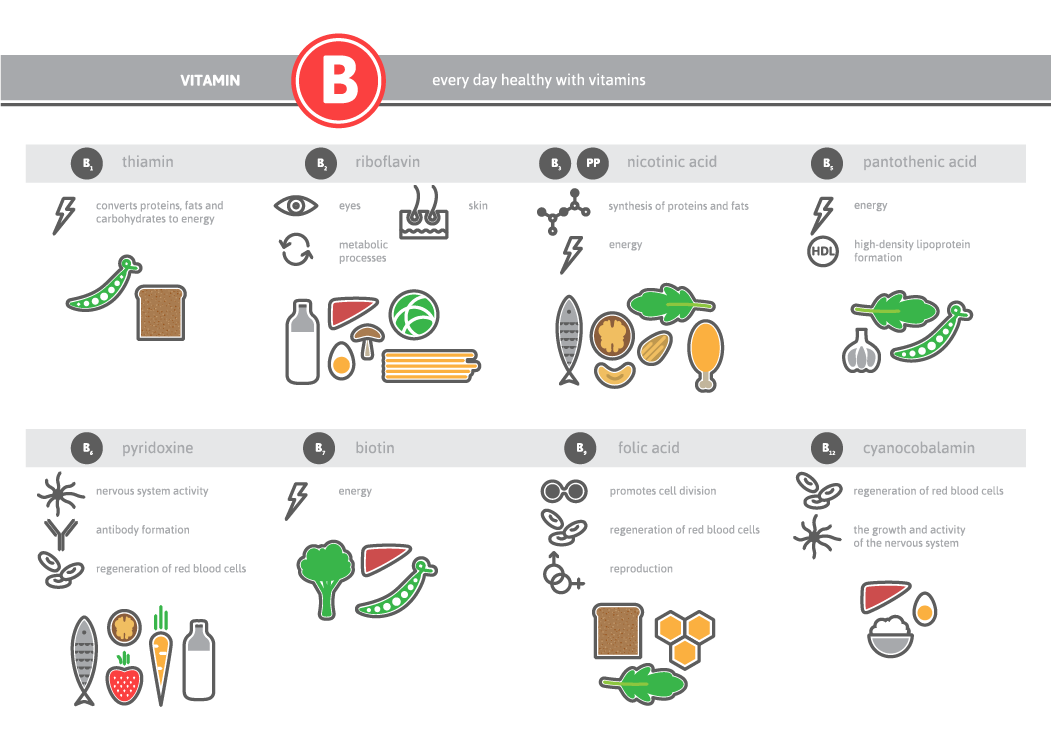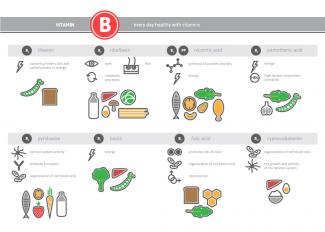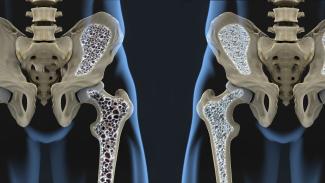B Vitamins: Should They Be Taken Together or Apart?
desouzanaturopathic.com
We know that vitamins play an important role in our energy and daily metabolic functions. We know that eating a balanced diet full of fruits and vegetables, can help lower the risk of chronic disease and support brain functions. B vitamins are crucial to brain health and can reduce the intensity of mental illness, including symptoms relating to anxiety, depression and chronic fatigue.
What are the B Vitamins?
There are 8 commonly known B vitamins, termed B1 -B12. They are essential nutrients to the human body and are largely found in vegetables, nuts and seeds, legumes and animal products. Each B vitamin has a specific role to play in human health and can create significant symptoms if they are deficient for a prolonged period of time.
Some of the most common symptoms of B vitamin deficiency include fatigue, PMS, stress, migraines, depression, neuropathy, and concurrent use of certain medications (birth control pill) (1).
In many medical offices, however, vitamin insufficiencies are easily overlooked. This leaves many patients undiagnosed for conditions that can be easily treated.
B1 – THIAMIN
Thiamin is a fundamental part of the energy pathways of the body. It plays a role in nerve conduction and

the processes needed to create genetic material. When absent, the result is the deficiency disease known as Beriberi, which can affect adults and children differently with symptoms such as cardiac weakness, muscle atrophy and pulmonary edema (2). Vitamin B1 is commonly found in pork, legumes and whole grains.
B2 – RIBOFLAVIN
This vitamin is found naturally in milk and milk products, however is very unstable and susceptible to destruction by light. Its role in energy metabolism is crucial, both on its own and in the synthesis of other B vitamins. There is no deficiency disease that results, however commonly associated symptoms include inflammation of the tongue, vision problems, anemia and depression. It is important to note that when taken in a B Complex formula, riboflavin is processed through the kidneys in a way that creates fluroescent urine. This can be alarming for some, but is a completely normal and harmless effect.
B3 – NIACIN
Vitamin B3 is arguably the most essential B vitamin in the formation and breakdown of all energy substrates; fatty acids, carbohydrates, etc. In order to be properly absorbed, it must be consumed with an alkaline solution, such as lime water. Those deficient in B3 are at risk of developing Pellagra, a disease characterized by dermatitis, diarrhea, dementia and resulting death (3). Niacin supplementation is common for treating high cholesterol, glucose intolerance and anxiety disorders. This can generate a niacin flush or reddening of the skin, which is normal and harmless. Niacin is fortified in cereals, but also found in meats, nuts and legumes.
B5 – PANTOTHENIC ACID
A vitamin that is found in nearly everything and is rarely ever deficient, pantothenic acid is an important factor in the synthesis of lipids for cholesterol, cell membrane structure, hormones and digestion. This means it is very important for providing healthy fats which are the backbones of estrogen, progesterone and testosterone. Pantothenic acid helps repair cell membranes, which is important for recovery from damage relating to things like smoking and excessive sun exposure. It can be used in the treatment of obesity, adrenal burnout, immune weakness and anxiety.
B6- PYRIDOXINE
This is a vitamin with many names, and is found in both plant and animal sources. B6 works with many other nutrients to help their individual functions, but has a lot of important functions on its own. Vitamin B6 plays a large role in the energy pathways, production of red blood cells and stimulation of the immune system. It is commonly used to treat carpal tunnel syndrome, cardiovascular disease and high cholesterol. Any woman experiencing a hormone imbalance and uncomfortable PMS symptoms should consider a B vitamin with a higher amount of B6.
An important note about vitamin B6 is that more is not better. In high doses, vitamin B6 can cause a non-permanent sensory neuropathy (4). This can present as odd neurological symptoms, including numbness, tingling and loss of sensation in peripheral nerves. For some individuals, toxicity symptoms can resemble deficiency symptoms. In this case, the best way to know is to discontinue B6 supplementation for a few weeks. If neurological symptoms disappear, it was likely to have been a vitamin B6 toxicity picture.
B7 – BIOTIN
Biotin is found in eggs whites, and is tightly bound to another protein called Avidin. Only when the egg is cooked is this bond broken and the biotin available for absorption. This B vitamin is essential for many enzymes involved in the breakdown of fatty acids. Deficiency results in disorders of the gastrointestinal system and poor absorption of fat-soluble nutrients.
B9- FOLATE
Nutritional research has demonstrated the importance of folate in the developing fetus and this has resulted in the mandatory fortification of cereals and grains. This vitamin is responsible for the transportation of methyl groups throughout the body, helping to create amino acids and DNA molecules. Folate deficiency is hard to determine, but can result in anemia and birth defects from a deficient mother.
There is a small subset of the population with a genetic inability to convert folate to its active methylated form. There are tests that can be done to determine this genetic variant, and should be considered in infertility and pregnancy, chronic mental health concerns and developmental disorders. If a patient is found to have this genetic variant, a methylated form of folate is available for supplementation.
B12- COBALAMIN
Most of the other vitamins have been absorbed through the walls of the stomach by their own transport mechanisms or concentration gradients. B12 is unique in that it requires a protein called Intrinsic Factor for its absorption. When this protein is deficient or absent, the B12 in the diet will not be absorbed and will result in symptoms of anemia, neurological deficits, and immune weakness.
B9 and B12 must often be supplemented together because they create the same deficiency symptoms and can often mask each other. Symptoms of low B12 can include neurological symptoms, memory loss in the elderly, depression and anxiety, infertility,

hypothyroidism and chronic fatigue (5). In those who are not experiencing deficiency symptoms, B12 can still contribute to the maintenance of good health. This can include lowering “bad” cholesterol, increasing energy, reducing sugar cravings and excessive appetite, reducing nerve pain, boosting focus and concentration and stabilizing mood.
Vitamin B12 can be tested through the blood and should be considered before supplementation or injection therapy. It is best to test B12 in conjunction with iron and a complete blood count to determine if the effects of insufficient B12 are showing up in the total number and size of red blood cells.
What about Multivitamins and B Complexes?
Each vitamin on its own has an essential function, but together, they can often be even more effective. Multivitamins and B complexes include all the different B vitamins in varied doses. Multivitamins include minerals and other vitamins, while B complexes only include the 8 vitamins discussed in this article.
The goal of a combination formula is to complement dietary intake and prevent deficiency. What this means, is that for the most part, an otherwise healthy individual should be able to reach their daily recommended intake from their diet alone. A combination formula of vitamins is ideal for preconception and pregnant women, patients with poor dietary habits and elderly people. In these populations, their requirements are either much higher or difficult to reach based on their lifestyle choices.
It is important to note the amounts of each vitamin in the formula when considering a new multivitamin. As mentioned in the article, for women combating PMS symptoms, a B complex higher in B6 would be preferable. For an individual considering support for adrenal burnout and fatigue, a product higher in B5 and B12 might be more suitable. In these particular cases, a combination formula may not be able to reach their requirements and supplementing individually may be a better option.
The good news about starting B vitamins is that the effects should be noticed within a matter of days. These effects could include increased energy and mental clarity. The only exception to this is in the use of B6 for PMS, which can take a number of cycles before noticing the effects. Remember to take B vitamins with food, which can help increase absorption and decrease any adverse effects including nausea. Overall, because B vitamins are water soluble, an excess amounts are excreted through the urine, they are generally considered safe in their daily recommended amounts.
It is important to recognize that many of the B vitamins work together. Therefore, a deficiency in one may cause another to become depleted, resulting in symptoms that do not indicate two deficient vitamins. This is why supplementing with a B complex vitamin is the best way to increase levels of all nutrients and prevent any masking of deficiency.
References
(1) Kennedy D. O. (2016). B Vitamins and the Brain: Mechanisms, Dose and Efficacy--A Review. Nutrients, 8(2), 68. https://doi.org/10.3390/nu8020068
(2)Wiley KD, Gupta M. Vitamin B1 Thiamine Deficiency (Beriberi) [Updated 2019 Dec 29]. In: StatPearls [Internet]. Treasure Island (FL): StatPearls Publishing; 2020 Jan-. Available from: https://www.ncbi.nlm.nih.gov/books/NBK537204/
(3) Savvidou S. (2014). Pellagra: a non-eradicated old disease. Clinics and practice, 4(1), 637. https://doi.org/10.4081/cp.2014.637
(4) Hemminger A, Wills BK. Vitamin B6 Toxicity. [Updated 2020 Jan 27]. In: StatPearls [Internet]. Treasure Island (FL): StatPearls Publishing; 2020 Jan-. Available from: https://www.ncbi.nlm.nih.gov/books/NBK554500/
(5) Langan, R (2017). Vitamin B12 Deficiency: Recognition and Management. Am Fam Physician. 2017 Sep 15;96(6):384-389.
































